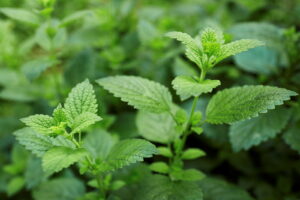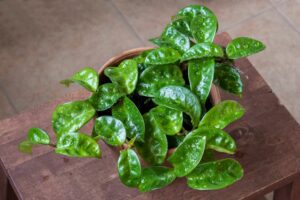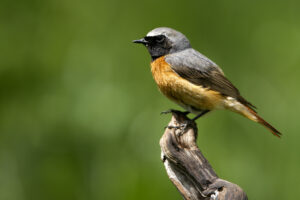Peace lily: flower, care & varieties
The beautiful peace lily has not earned its reputation as a classic houseplant for nothing. Here is how to plant and care for the decorative, low-maintenance peace lily at home.
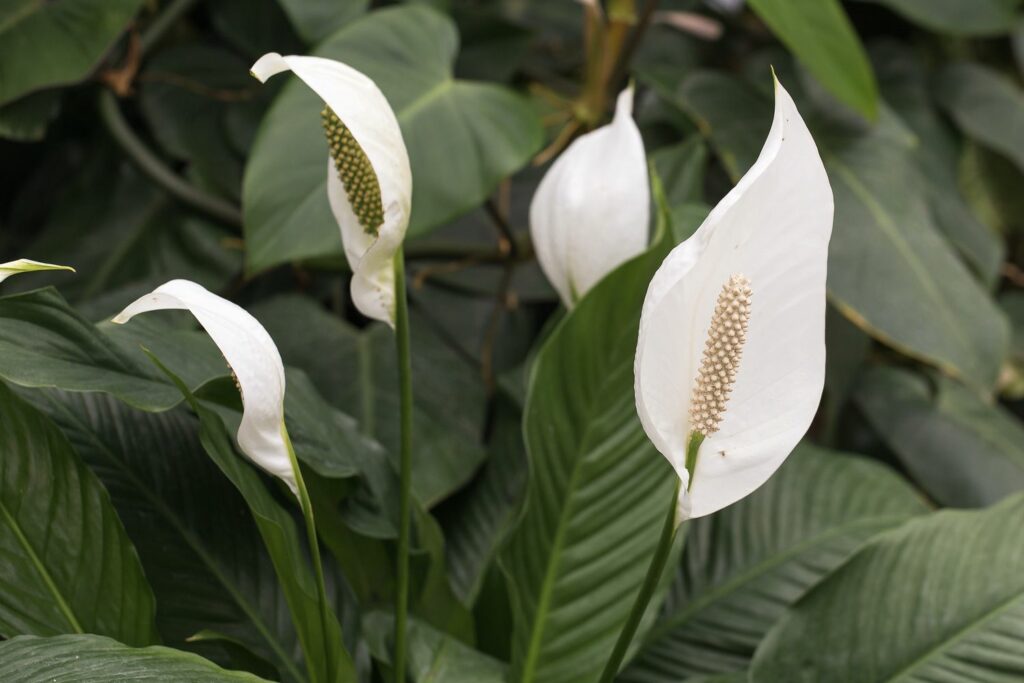
With its elegant and timeless appearance, the peace lily (Spathiphyllum) blends into any room. It is ideal for inexperienced hobby gardeners and comes in a variety of different heights and leaf colours. Here are our top tips on caring for the peace lily at home.
Contents
Peace lily: flowering and characteristics
Peace lilies grow in bunches of stems that, depending on the variety, reach between 30 and 150 cm tall. The stems produce decorative flowers and rich, dark green, oval leaves that have a beautiful sheen on their upper sides. The leaves contrast with the peace lily’s colourful bracts, which, depending on the variety, are either brilliant white or cream. Bracts are modified leaves that surround the peace lily’s bulb shaped flower. This is typical of the Arum genus (Araceae), and you should expect to see these flowers between June and September. Depending on the variety and the time of year, the flowers can have a pleasantly light and sweet fragrance.
The most beautiful peace lily species and varieties
Each species of peace lily differs in height, flower shape and colour. There are over 50 different species of peace lily, the most popular of which include Spathiphyllum floribundum and Spathiphyllum wallisii. The former consists of varieties that are characterised by large flowers and tall growth – over 50 cm. For a smaller plant, varieties of Spathiphyllum wallisii are a better choice. They have smaller flowers and reach only 30 cm tall. Most peace lily plants on the market are hybrids, so they will cross characteristics of these different species.
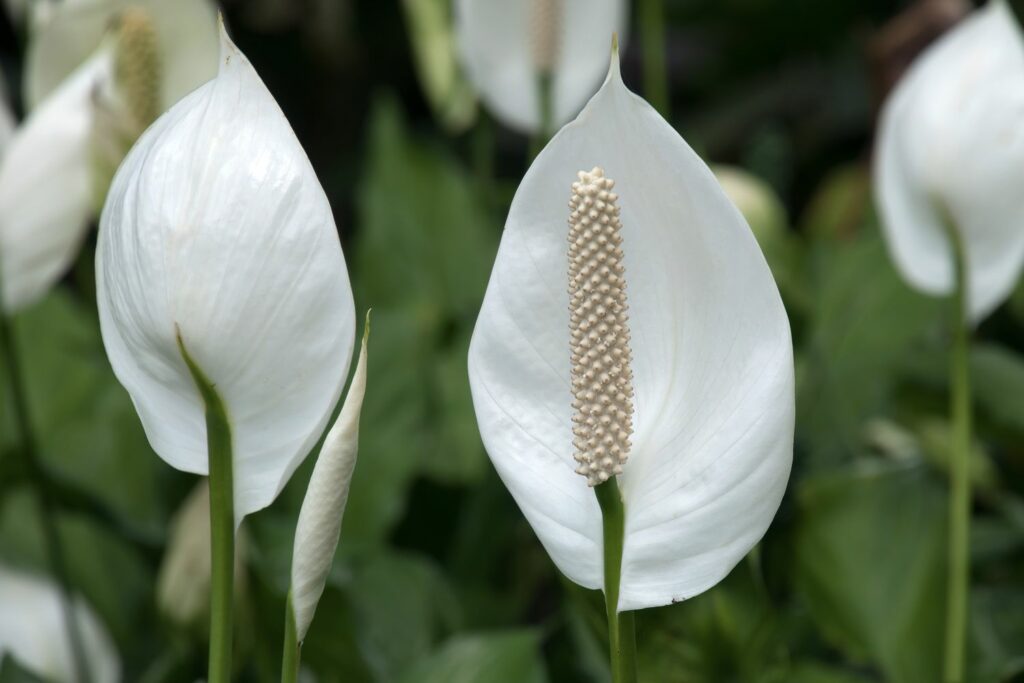
Spathiphyllum floribundum ‘Chopin’
Spathiphyllum floribundum ‘Chopin’ is perfect for those needing a simple, elegant peace lily. It has dark green leaves, and flowers that are adorned with a brilliant white bracts. ‘Chopin‘ reaches a maximum height of 60 cm.
Spathiphyllum wallisii ‘Gemini’
The variety Spathiphyllum wallisii ‘Gemini’ has striking, irregular white stripes across its leaves, and eye-catching white to cream-coloured flowers. ‘Gemini’ grows to about 30 cm, so is a compact variety.
Spathiphyllum wallisii ‘Variegata’
The variety Spathiphyllum wallisii ‘Variegata’ is very similar to ‘Gemini’, except its leaves have stronger white streaks. It grows to a height of about 30 cm.
Spathiphyllum wallisii ‘Sensation’
This variety lives up to its name. Spathiphyllum wallisii ‘Sensation’ is one of the largest sheath-like leaf varieties. Growing to a height of over 150 cm, it is best grown on the ground or on a small pedestal.
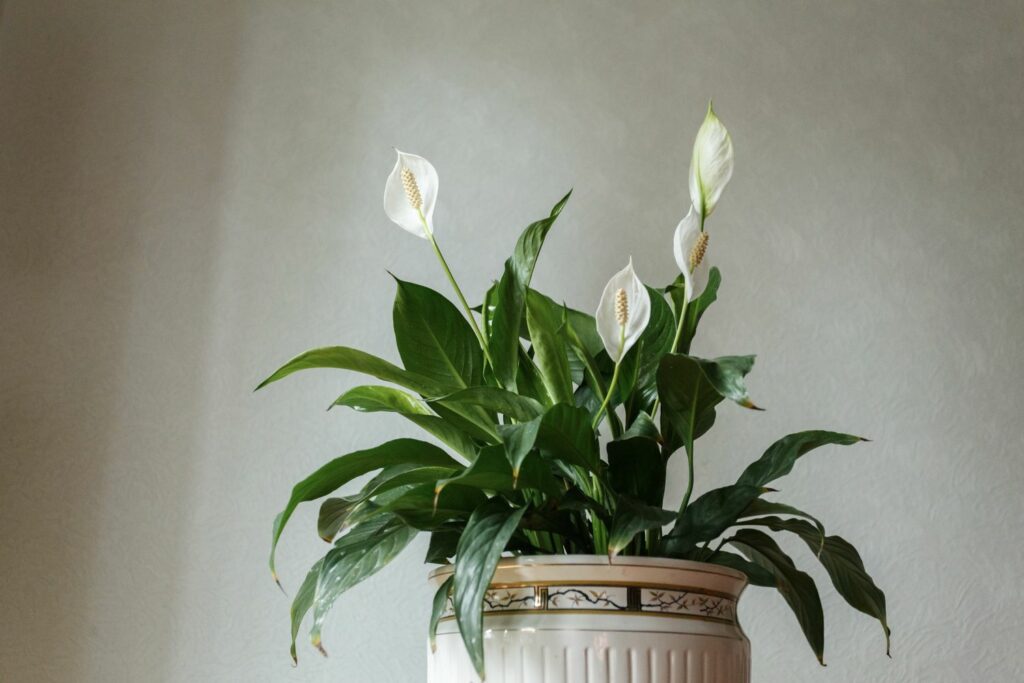
Spathiphyllum ‘Pearl Cupido’ (hybrid)
The hybrid ‘Pearl Cupido’ is characterised by particularly dark green, elliptical (or lanceolate) leaves. These leaves can reach a length of up to 90 cm, making ‘Pearl Cupido’ a tall-growing variety.
Spathiphyllum ‘Sweet Paco’ (hybrid)
‘Sweet Paco’ has a uniquely intense, pleasantly sweet fragrance. This fragrance is emitted by each of its brilliant white flowers for about half a day after blooming. This behaviour is unlike any other for the peace lily.
Planting peace lilies: location and soil
Looking for a plant that will grow in a room too dark for most other plants? Then look no further! Peace lilies are extremely shade tolerant.
Nevertheless, you should try to provide the plant with as much light as possible. The more light it gets, the better it grows. But be careful! Peace lilies do not enjoy direct sunlight. A room with a north facing window, at about 18 to 25°C is ideal. And don’t forget, your peace lily will appreciate some humidity, so the bathroom might be the ideal location for it!
Tip: If your peace lily starts to grow very slowly, and the leaves become increasingly dark green, move it to a brighter location. If, instead, your lily develops brown tips, move it away from any direct sunlight.
Once you have found a suitable location, pot your peace lily in spring. Select a plant pot that has a hole at the bottom, out of which excess water can drain. Peace lilies do not usually need much soil, but they do benefit from a high humus content and good aeration of the roots. You can find all of this in our peat-free Plantura Organic All Purpose Compost!
Tip: Peace lilies also grow well in a hydroponic system with expanded clay.

Peace lily care: top tips
Generally speaking, the peace lily is a perfect plant for beginner gardeners. However, there are some things you will need to keep in mind. Peace lily is most at home in a rainforest, so it will appreciate some humidity. The lily will tolerate dry air for a short time, but try to spray it two or three times a week with low-lime water, especially in winter. It is also a good idea to wipe your peace lily’s leaves occasionally, to prevent them from gathering dust, which hinders photosynthesis.
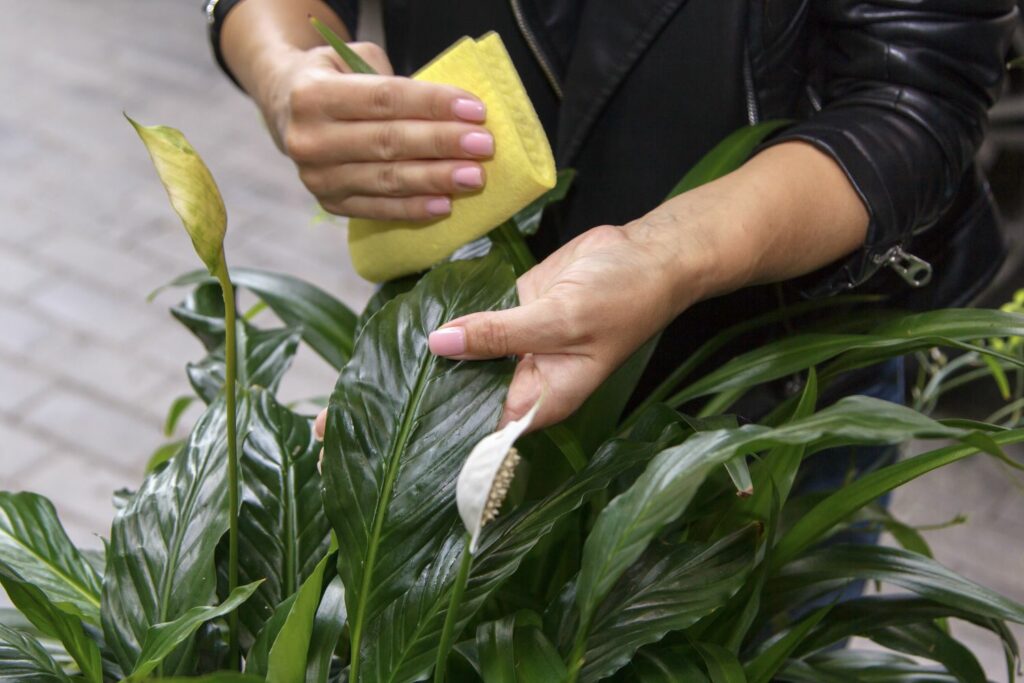
Watering and fertilising Spathiphyllum
In keeping with the peace lily’s natural environment, it is important to keep the soil around the root ball moist. Avoid waterlogging by removing excess water from the pot as soon as possible. Rainwater is ideal for watering, but mineral water also works well.

With enough nutrition, Spathiphyllum will grow strong and produce lots of flowers. To support flower formation, we recommend that you fertilise your peace lily regularly between spring and late summer. A liquid fertiliser, such as our Plantura Liquid Houseplant Food, is particularly well suited for this. It provides your peace lily with essential nutrients and contains microorganisms that promote strong root growth.
To apply Plantura Liquid Houseplant Food, shake the bottle well, add 15-25 ml of the fertiliser to 5 litres of water, and water your peace lily once a week from March to October using this fortified water. And have no fear: our liquid fertiliser is harmless to pets and garden animals!

- Perfect for a wide variety of houseplants & foliage plants
- Liquid fertiliser for robust plants & healthy growth
- Quick & easy application - child & pet friendly
Transplanting Peace lilies
It is a good idea to transplant your peace lily every two to three years, depending on how fast it grows. Spring or early summer is the best time to do this. Select a pot that is about four centimetres larger in diameter than the previous one, and make sure it has a hole at the bottom to drain off excess water.
Tip: Make sure your new pot is not too large. If the leaf tips rest on the soil, they may develop brown tips.
For a long-lasting supply of nutrients, we recommend adding a granulated fertiliser that will release its nutrients into the soil slowly, like our Plantura Flower Food. In particular, remember that phosphorus is essential for abundant flowering.
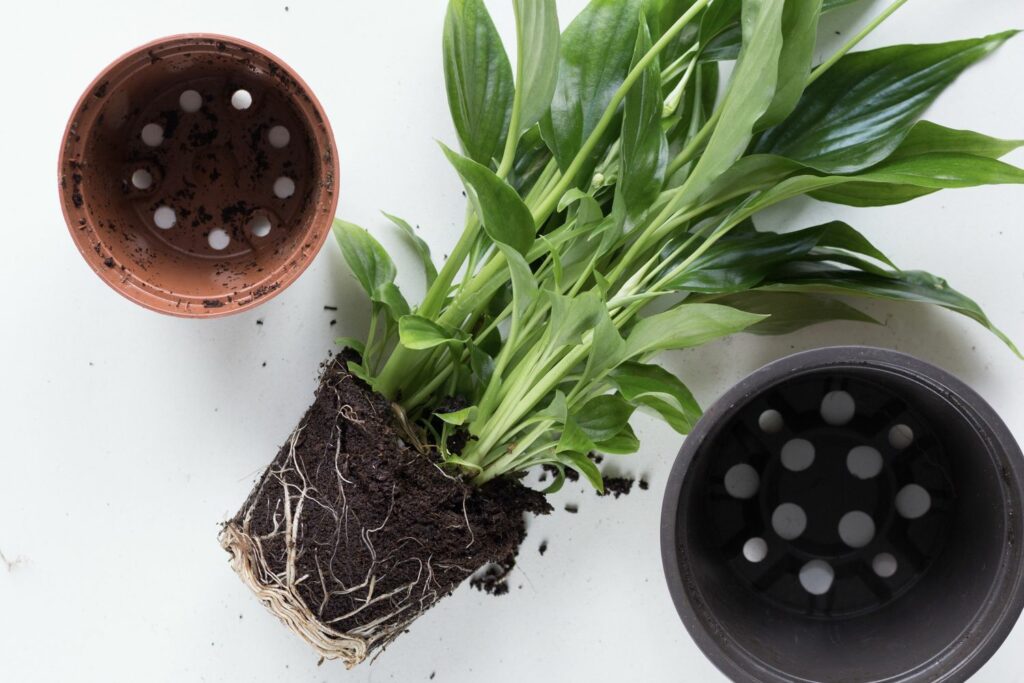
Peace lily pruning
You need not prune your peace lily, and, in fact, it might do it harm. Just be sure to remove older, dying leaves using a sharp pair of scissors at the base of the stem.
Peace lily pests and diseases
The peace lily is not very susceptible to pests and diseases. In rare cases, it may suffer from an infestation of aphids. These pests multiply rapidly, particularly in warm rooms, so regularly check for their presence, especially in winter.
Why have my peace lily leaves turned yellow?
There are a number of reasons why the leaves of your peace lily might turn yellow:
- Nitrogen deficiency: Leaves uniformly lighten, and yellow discoloured, old leaves.
Solution: Weekly use of a liquid fertiliser specially formulated for houseplants, such as our Plantura Liquid Houseplant Food. - Waterlogging: Uniform paling of the leaves and yellow tips.
Solution: Water less and remove excess water. - Insufficient humidity: Yellow or brown leaf tips.
Solution: Spray the plant with water. - Iron or magnesium deficiency: Young leaves lighten, leaf veins or centre remains green.
Solution: Repot peace lily, be sure to water the plant with acidic water (not tap water).

Tip: For efficient nutrient uptake, the peace lily needs a slightly acidic soil with a pH of 5 to 6. This is why acidic rainwater is a great choice, it has a pH of approximately 5.5.
Why has my peace lily stopped flowering?
There may be several reasons why your peace lily is no longer flowering:
- Its location is too bright or too dark.
- It received insufficient or incorrect nutrients. This can also cause stunted growth. For instance, pure nitrogen fertilisers can inhibit flower formation.
Peace lily propagation
You can propagate your peace lily by dividing its stalk. The best time to do this is when you are transplanting your lily. To do this, follow these steps:
- Put on gloves; the sap of the peace lily is an irritant.
- Remove soil from the roots and rhizomes (thickened stems).
- Select a rhizome with 3–4 leaves, and cut it off with a sharp knife.
- Plant the rhizome in another pot and water.
- Care for the offshoot in the same way as the mother plant.
- After a few weeks, the new peace lily should begin to grow.
Is Spathiphyllum poisonous?
Yes, Spathiphyllum is slightly poisonous. All parts of the plant contain substances that irritate mucous membranes, and oxalic acids, which can cause irritation when they come into contact with plant sap. For this reason, you should prevent children or pets from swallowing any parts of your peace lily.
Another low-maintenance and beautifully decorative houseplant is the Monstera adansonii. This tropical plant can also be grown in darker spaces.


